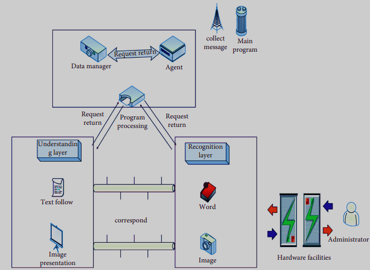Research on Innovation in the Design of Museum Tourist Souvenirs Based on Artificial Intelligence
Keywords:
Artificial intelligence, Innovation, Multivariate regression, Museum tourist, Wireless network systemAbstract
Various chores that humans once thought to be laborious have been made simpler as a result of technological innovation. Artificial intelligence technology has advanced quickly and is now being utilised to help people handle tasks more efficiently. Artificial intelligence and wireless network systems are tasked with designing museum souvenirs. The study used multivariate regression classifier for evaluating the efficiency. In this study, we will conduct research on artificial intelligence-based innovation in the design of museum tourist souvenirs. The study results has provided an accuracy of 99.45%.
Downloads
References
C. M. Wu and P. Li, “Based on the sustainable development conception of research the Shanghai tourist suvenirs design,” Adv. Mat. Res., pp. 1553–1556, Aug. 2013, doi: 10.4028/www.scientific.net/amr.753-755.1553.
Q. Yang, “Research on design innovation for reshaping local cultural characteristics of the tourist souvenirs,” E3S Web Conf., pp. 02087, 2020, doi: 10.1051/e3sconf/202017902087.
X. T. Zhao, C. Jiang, L. L. Chen, and J. J. Gao, “Research on tourist souvenirs design method based on gene engineering,” Appl. Mech. Mater., pp. 1274–1277, Aug. 2013, doi: 10.4028/www.scientific.net/amm.365-366.1274.
W. Souffriau, P. Vansteenwegen, J. Vertommen, G. V. Berghe, and D. V. Oudheusden, “A personalized tourist trip design algorithm for mobile tourist guides,” Appl. Artif. Intell., no. 10, pp. 964–985, Oct. 2008, doi: 10.1080/08839510802379626.
H. -M. Du and S. -M. Zhang, “The Cloud Design System Building Research of Tourist Souvenirs,” DEStech Trans. Eng Technol. Res, no. sste, Mar. 2017, doi: 10.12783/dtetr/sste2016/6512.
S. Y. Yang, “Design development of cultural and tourist souvenirs using charactergram,” Journal Korea Design Knowledge, no. 20, pp. 265–274, Dec. 2011, doi: 10.17246/jkdk.2011..20.026.
S. W. Kim, “Development of graphic design for diversity of tourist souvenirs in Buyeo, Baekje,” Korea Institute of Design Research Society, no. 4, pp. 201–211, Dec. 2020, doi: 10.46248/kidrs.2020.4.201.
F. Basri and M. Bakhtiar, “Craft souvenirs,” in Hospitality and Tourism, CRC Press, 2013, pp. 141–145.
Z. Qi and L. Hong, “Study on design and research of tourist souvenirs on the background of low-carbon economy,” Energy Procedia, pp. 2416–2420, 2011, doi: 10.1016/j.egypro.2011.03.415.
P. Caterina and B. Alessandro, “Evolutionary time lines, hypothesis of an AI+AR–Based virtual museum,” in Representation Challenges. Augmented Reality and Artificial Intelligence in Cultural Heritage and Innovative Design Domain, FrancoAngeli srl, 2021.
B. Wang, “Digital design of smart museum based on Artificial Intelligence,” Mob. Inf. Syst., pp. 1–13, Dec. 2021, doi: 10.1155/2021/4894131.
D. Usynin et al., “Adversarial interference and its mitigations in privacy-preserving collaborative machine learning,” Nat. Mach. Intell., no. 9, pp. 749–758, Sep. 2021, doi: 10.1038/s42256-021-00390-3.
W. Li, Q. Yang, and W. Du, “Tourist sentiment mining based on deep learning,” in Artificial Intelligence, IntechOpen, 2022.
Y. Yang and Z. Sha, “Research on innovation of design education based on Artificial Intelligence technology,” J. Phys. Conf. Ser., no. 1, pp. 012055, Dec. 2021, doi: 10.1088/1742-6596/2136/1/012055.
C. Anastasiadou and S. Vettese, “From souvenirs to 3D printed souvenirs’. Exploring the capabilities of additive manufacturing technologies in (re)-framing tourist souvenirs,” Tour. Manag., pp. 428–442, Apr. 2019, doi: 10.1016/j.tourman.2018.10.032.
M. Akal, “Forecasting Turkey’s tourism revenues by ARMAX model,” Tour. Manag, vol. 25, no. 5, pp. 565–580, 2004
P. Chhetri, “Modelling the attractiveness potential of scenic views: A case study of the Grampians national park, Australia,” Tour. Recreat. Res., vol. 31, no. 3, pp. 101–107, 2006.
M. Dragouni, G. Filis, K. Gavriilidis, D. Santamaria, “Sentiment, mood and outbound tourism demand,” Ann. Tour. Res., vol. 60, pp. 80–96, 2016.

Downloads
Published
How to Cite
Issue
Section
License
Copyright (c) 2022 Lilan Ding

This work is licensed under a Creative Commons Attribution-ShareAlike 4.0 International License.
All papers should be submitted electronically. All submitted manuscripts must be original work that is not under submission at another journal or under consideration for publication in another form, such as a monograph or chapter of a book. Authors of submitted papers are obligated not to submit their paper for publication elsewhere until an editorial decision is rendered on their submission. Further, authors of accepted papers are prohibited from publishing the results in other publications that appear before the paper is published in the Journal unless they receive approval for doing so from the Editor-In-Chief.
IJISAE open access articles are licensed under a Creative Commons Attribution-ShareAlike 4.0 International License. This license lets the audience to give appropriate credit, provide a link to the license, and indicate if changes were made and if they remix, transform, or build upon the material, they must distribute contributions under the same license as the original.





